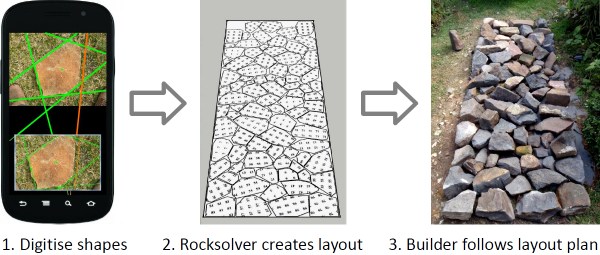Rocksolver software can pack 2D shapes into a square or rectangular container. The shapes can be taken from photos of stone pavers or they can be pieces to cut out of fabric or sheet metal.
Rocksolver is currently (January 2018) undergoing prototype testing.
Future versions of Rocksolver will pack concave 2D shapes into irregular-shaped areas and will have the capability to include colour and texture data in the design criteria. We are also developing a Sketchup plugin to make it easy to digitise 2D shapes.
You might be interested in a Rocksolver capable of packing objects which are irregularly shaped in all 3 dimensions. We are working on it. Rocks will be digitised by passing them between two cameras then Rocksolver works out the 3D layout and conveys the information to the builder via on-board displays (in an excavator, for example) or through augmented reality glasses for small rocks to build houses.
Some background on the Rocksolver story.
Intresto (Intelligent Rearrangement of Stone) has tackled a particularly difficult problem – how to use software to optimise the packing of irregular-shaped 2D and 3D objects to build stable structures (the Rocksolver method).
Since 2007 Intresto has gained patents in Australia and the US (pending in Europe) on the Rocksolver method and has developed original algorithms to aid in the building of the world’s first computer-optimised dry stone walls.
Malcolm Lambert is the inventor of Rocksolver and has built a formidable Sydney-based team including software engineers Dr Paul Kennedy and Todd Farrell, computer-aided engineering specialist Emeritus Professor Grant Steven and seasoned business owner Peter Douglas.
During 2013 prototype 2D Rocksolver layout plans were used to demonstrate proof-of-concept in real-world landscaping jobs and our Android smart phone app and Sketchup plug-in are being developed to enable a world-wide release during 2014.
3D structures have been built using Rocksolver’s 2D algorithm to pack prism-shaped rocks and the packing algorithm is being refined to deal with rocks which are irregular in all 3 dimensions to make use of all rock shapes.



